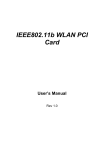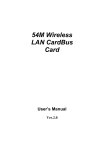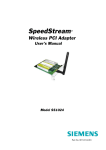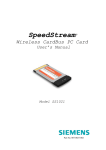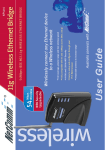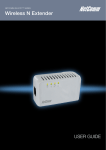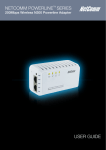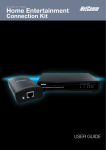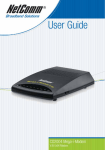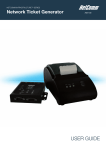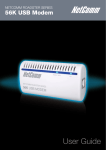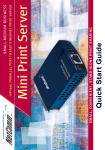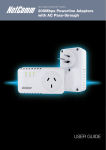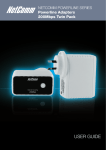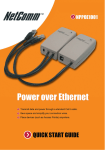Download NetComm NP5420 User's Manual
Transcript
Contents Introduction .................................................................................................................... 3 Package Contents ........................................................................................... Features ........................................................................................................... What is Wireless LAN? .................................................................................... Wireless LAN Modes ....................................................................................... Notes on Wireless LAN Configuration ............................................................ 4 5 6 7 8 Hardware Installation .................................................................................................... 9 System Requirements for the Card ................................................................ 9 Install the PCI Adapter ..................................................................................... 9 Connecting the Adjustable Antenna to the Card ............................................ 10 LED Indicators ................................................................................................ 11 Driver Installation ......................................................................................................... 12 Driver Driver Driver Driver installation for Windows XP ................................................................ installation for Windows ME ................................................................ installation for Windows 2000 ............................................................ installation for Windows 98 ................................................................. 12 14 16 19 Installing and Using the WLAN Utility ......................................................................... 22 Installation in Windows ................................................................................. 22 Using Wireless Utility In Windows XP ........................................................... 24 Using the NetComm NP5420 WLAN Utility In Windows 98/2000/ME .......... 28 Appendix A: FAQ .......................................................................................................... 33 Appendix B: Troubleshooting ..................................................................................... 34 Installing Network Protocols .......................................................................... 34 Disabling Windows XP’s Wireless Zero Configuration ................................ 34 Appendix C: Specifications ......................................................................................... 36 Appendix D: Registering your NetComm Product ..................................................... 36 Trademarks and Notices ............................................................................... Warranty Registration Form .......................................................................... Product Warranty ............................................................................................ Limitations of Warranty .................................................................................. www.netcomm.com.au Page 2 36 37 39 39 Rev. 1 - YML678 NP5420 11G Wireless PC Card User Guide Introduction Congratulations on your purchase of the NetComm NP5420 11G Wireless PC Card. This PCI card provides you with an innovative wireless networking solution. The NP5420 is easy to set up and use, and with this wireless technology, you can share files and network resources on the network—without inconvenient wires! The Card is a network Adapter with 54Mbps data rate operating in the ISM band implementing the IEEE 802.11g standard. This Adapter provides Device Drivers for Windows Operating Systems. It also provides tools for the configuration of the Card. The tool, as well as the installation steps of the plug-and-play procedure for the Windows operating systems, is described in this document. Follow these installation steps to ensure the quick and easy installation of your NetComm NP5420 11G Wireless PC Card: 1. Read the documentation and plan the installation. 2. Install the hardware. 3. Install the drivers. 4. Install and use NetComm's WLAN Utility or use Windows XP WLAN utility (XP only). Rev. 1 - YML678 NP5420 11G Wireless PC Card User Guide www.netcomm.com.au Page 3 Package Contents The following items should be contained in your NP5420: ❏ NetComm’s NP5420 11G Wireless PC Card and external antenna ❏ NetComm Driver / Utility CD-ROM (a copy of this user’s manual included) ❏ User Guide and Package Contents Note. If any of the above items are damaged or missing, please contact your dealer immediately. www.netcomm.com.au Page 4 Rev. 1 - YML678 NP5420 11G Wireless PC Card User Guide Features The NetComm NP5420 11G Wireless PC Card complies with the IEEE 802.11g specification, allowing it to communicate with other wireless devices that support the standard. Features of the NP5420 are: ■ 2.4GHz frequency band, which complies with the worldwide requirement ■ Wireless interface following the IEEE 802.11g standard ■ PCI interface ■ Enciphering/deciphering of wireless data by the implementation of the WEP algorithm ■ Wire-free access to networked resources beyond the desktop ■ Allows users move between Access Points without resetting their connection configuration ■ Data rate of up to 54 Mbps ■ IEEE802.11g WLAN Card Configuration utility ■ External Antenna with LEDs indicating Power and Link ■ Supports most popular operating systems Rev. 1 - YML678 NP5420 11G Wireless PC Card User Guide www.netcomm.com.au Page 5 What is Wireless LAN? Wireless Local Area Network (WLAN) systems offer a great number of advantages over traditional wired systems. WLAN is flexible and easy to setup and manage. Using radio frequency (RF) technology, a WLAN transmits and receives data through the air. A WLAN combines data connectivity with user mobility. For example, users can roam from a conference room to their office without being disconnected from the network. Using WLAN, users can conveniently access-shared information, and network administrators can configure and augment networks without installing or moving network cables. WLAN technology provides users with many convenient and cost saving features: Mobility: WLAN provide LAN users with access to real-time information anywhere in their organization, providing service opportunities that are impossible with wired networks. Ease of Installation: Installing is easy for novice and expert users alike, eliminating the need to install network cables in walls and ceilings. Scalability: WLAN can be configured in a variety of topologies to adapt to specific applications and installations. Configurations are easily changed and range from peer-to-peer networks suitable for a small number of users to full infrastructure networks of thousands of users roaming over a broad area. www.netcomm.com.au Page 6 Rev. 1 - YML678 NP5420 11G Wireless PC Card User Guide Wireless LAN Modes Wireless LANs can be configured in one of two ways: Ad-hoc Networking Also known as a peer-to-peer network, an ad-hoc network is one that allows all workstations and computers in the network to act as servers to all other users on the network. Users on the network can share files, print to a shared printer, and access the Internet with a shared modem. However, with ad-hoc networking, users can only communicate with other wireless LAN computers that are in the same wireless LAN workgroup, and are within range. Infrastructure Networking Infrastructure networking differs from ad-hoc networking in that it includes an access point. Unlike the ad-hoc structure where users on the LAN contend the shared bandwidth, on an infrastructure network, the access point can manage the bandwidth to maximize its utilization. Additionally, the access point enables users on a wireless LAN to access an existing wired network, allowing wireless users to take advantage of the wired networks resources, such as Internet, email, file transfer, and printer sharing. Rev. 1 - YML678 NP5420 11G Wireless PC Card User Guide www.netcomm.com.au Page 7 Infrastructure networking has the following advantages over ad-hoc networking: Extended range: Each wireless LAN computer within the range of the access point can communicate with other wireless LAN computers within range of the access point. Roaming: The access point enables a wireless LAN computer to move through a building and still be connected to the LAN. Wired to wireless LAN connectivity: The access point bridges the gap between wireless LANs and their wired counterparts. Notes on Wireless LAN Configuration When configuring a wireless LAN (WLAN), be sure to note the following points: ■ Optimize the performance of the WLAN by ensuring that the distance between access points is not too far. In most buildings, WLAN Adapters operate within a range of 10 ~ 30 metres, depending on the thickness and structure of the walls. ■ Radio waves can pass through walls and glass but not metal. If there is interference in transmitting through a wall, it may be that the wall has reinforcing metal in its structure. Install another access point to circumvent this problem or try moving your existing access point. ■ Floors usually have metal girders and metal reinforcing struts that interfere with WLAN transmission. It is recommended that you use at least one access point for each level of your building. www.netcomm.com.au Page 8 Rev. 1 - YML678 NP5420 11G Wireless PC Card User Guide Hardware Installation This section gives detailed instructions for connecting your NB5420 to a PCI slot of a desktop computer. System Requirements for the Card ■ Operating System: Microsoft Windows 98/ME/2000/XP ■ Desktop computer with a CD-ROM drive ■ One free PCI slot ■ Pentium-Class 90MHz or higher Install the PCI Adapter NOTE: These instructions apply to most desktop computers. For detailed information on inserting a PCI Adapter into your desktop computer, consult the desktop computer User’s Manual. 1. Turn off the computer‚ unplug the power cord and remove the computer's cover. 2. Pick a free PCI expansion slot and remover the protective bracket. 3. Insert the Card into the slot until it is fully seated. 4. Secure the Card bracket with the screw from step 2. 5. Replace the computer’s cover. 6. Reconnect the power cord and turn on the computer. Rev. 1 - YML678 NP5420 11G Wireless PC Card User Guide www.netcomm.com.au Page 9 Connecting the Adjustable Antenna to the Card After installing the Card on computer, connect external Antenna to the Card from the SMA connector. Hold the antenna in the desired orientation and then turn the lock nut clockwise until snug (do not over tighten the nut). To adjust the antenna direction, turn the nut counter clockwise one full turn, adjust the antenna and then tighten the nut. After hardware installation is completed, please go to the Driver Installation section and follow the instructions for your operating system. www.netcomm.com.au Page 10 Rev. 1 - YML678 NP5420 11G Wireless PC Card User Guide LED Indicators The following table describes the meaning of LED indicators: LED MEANING POWER Indicates that the Card is powered on (solid green). LINK Indicates link status. The LED lights up (solid green) while the wireless connection is linked. The LED is blinking green while wireless data transmitting / receiving. Rev. 1 - YML678 NP5420 11G Wireless PC Card User Guide www.netcomm.com.au Page 11 Driver Installation The following sections cover the installation of the NetComm NP5420 WLAN PCI Card driver in Windows Operating Systems. Note: You have to install your hardware first before you begin to install the drivers. Driver installation for Windows XP Follow the steps below to install the NP5420 11G Wireless PC Card drivers for Windows XP. 1. Insert the NP5420 into a spare PCI slot in your desktop PC. (Refer to the section on Hardware installation for instructions.) 2. After Windows XP detects the NP5420, the Found New Hardware Wizard window appears. Select Install the software automatically [Recommended] and insert the driver CD-ROM into CD-ROM drive and click Next to continue. 3. The following screen will appear. Click Continue Anyway to continue the installation. www.netcomm.com.au Page 12 Rev. 1 - YML678 NP5420 11G Wireless PC Card User Guide 4. The Windows has finished installing software for the device. Click Finish to complete the installation The system will start to install the Wireless LAN Utility. Proceed to the section on Installing and Using the Wireless Utility for information on installation and configuration. Rev. 1 - YML678 NP5420 11G Wireless PC Card User Guide www.netcomm.com.au Page 13 Driver installation for Windows ME Follow the steps below to install the NP5420 11G Wireless PC Card drivers for Windows ME. 1. Insert the NP5420 into a spare PCI slot in your desktop PC. (Refer to the section on Hardware installation for instructions.) 2. After Windows ME detects the NP5420 11G Wireless PC Card, the Add New Hardware Wizard window appears. Select Automatic search for a better driver (Recommended) and insert the driver CD-ROM into CD-ROM drive and click Next to continue. 3. The system will find the setup files and follow the instruction to copy files to your hard disk. The following screen will appear when the software installation has finished. Click Finish to complete the installation. 4. The following screen will ask you to restart your computer to finish the hardware setting up. Click Yes to reboot the system. www.netcomm.com.au Page 14 Rev. 1 - YML678 NP5420 11G Wireless PC Card User Guide After system reboot, the Wireless LAN Utility will be installed automatically. Proceed to the section on Installing and Using the Wireless Utility for information on installation and configuration. NOTE: In most cases, Windows will automatically copy all of the files needed for networking. If Windows asks you for the files and prompts you to input the path to the files. Follow the instructions on your screen, and then click OK to continue. Rev. 1 - YML678 NP5420 11G Wireless PC Card User Guide www.netcomm.com.au Page 15 Driver installation for Windows 2000 Follow the steps below to install the NP5420 11G Wireless PC Card drivers for Windows 2000. 1. Insert the NP5420 into a spare PCI slot in your desktop PC. (Refer to the section on Hardware installation for instructions.) 2. After Windows 2000 detects the NP5420 11G Wireless PC Card, the Found New Hardware Wizard window appears. Click Next to start the installation. 3. A screen appears prompting you to select an installation method. Select Search for a suitable driver for my device (recommended) and click Next to continue. www.netcomm.com.au Page 16 Rev. 1 - YML678 NP5420 11G Wireless PC Card User Guide 4. Ensure that the CD-ROM driver is selected and insert the driver CD-ROM into your CDROM drive. Click Next to continue. 5. The following screen appears showing the driver search result. Click Next to continue the installation. Rev. 1 - YML678 NP5420 11G Wireless PC Card User Guide www.netcomm.com.au Page 17 6. The following screen appears. Click Yes to continue 7. The Windows has finished installing software for the device. Click Finish to complete the installation. The system will start to install Wireless LAN Utility. Proceed to the section on Installing and Using the Wireless Utility for information on installation and configuration. www.netcomm.com.au Page 18 Rev. 1 - YML678 NP5420 11G Wireless PC Card User Guide Driver installation for Windows 98 Follow the steps below to install the NP5420 11G Wireless PC Card drivers for Windows 98. 1. Insert the NP5420 into a spare PCI slot in your desktop PC. (Refer to the section on Hardware installation for instructions.) 2. After Windows 98 detects the NP5420 11G Wireless PC Card, the Add New Hardware Wizard window appears. Clicks Next to continue the installation. 3. A screen appears prompting you to select an installation method. Select Search for the best driver for your device. (Recommended) and click Next to continue. Rev. 1 - YML678 NP5420 11G Wireless PC Card User Guide www.netcomm.com.au Page 19 4. Ensure that the CD-ROM drive is selected. Insert the driver CD-ROM into your CD-ROM drive and click Next to continue. 5. The following screen appears showing the driver search result. Click Next to continue the installation. 6. Windows 98 copies files to your hard disk. The following screen will appear to inform you when the software installation has finished. Click Finish to complete the installation. www.netcomm.com.au Page 20 Rev. 1 - YML678 NP5420 11G Wireless PC Card User Guide 7. The following screen will ask you to restart your computer to finish the installation. Click Yes to reboot the system. After system reboot, the Wireless LAN Utility will be installed automatically. Proceed to the section on Installing and Using the Wireless Utility for information on installation and configuration. NOTE: In most cases, Windows will automatically copy all of the files needed for networking. If Windows asks you for the files and prompts you to input the path to the files. Follow the instructions on your screen, and then click OK to continue. Rev. 1 - YML678 NP5420 11G Wireless PC Card User Guide www.netcomm.com.au Page 21 Installing and Using the WLAN Utility The following sections cover the NetComm NP5420 WLAN Utility installation and configuration. Installation in Windows After you have installed the driver, the system will start to install the NetComm NP5420 WLAN Utility. Please follow the steps below to install the utility. 1. Once you see the following screen, click Next to continue. 2. The screen will show you the default destination chosen by the utility. Click Next to continue or click the Browse button to select an alternate destination. www.netcomm.com.au Page 22 Rev. 1 - YML678 NP5420 11G Wireless PC Card User Guide 3. The following screen allows you to review and change the settings before completing the installation. Click Next to continue or click Back to review or change any settings. 5. Windows has finished installing Wireless LAN Utility. Click Finish to finish the installation. Rev. 1 - YML678 NP5420 11G Wireless PC Card User Guide www.netcomm.com.au Page 23 Using Wireless Utility In Windows XP Wireless LAN Utility There are two ways to configure the NetComm NP5420 11G Wireless PC Card. One is using the NetComm NP5420 WLAN Utility; the other one is using Windows XP’s Wireless Network Configuration. Once your NP5420 card is installed and your operating system has drivers loaded you must configure a WLAN Utility to specify the correct settings to join your Wireless LAN. Windows XP comes with a built-in WLAN utility, you can choose to use the XP utility or use NetComm's utility as provided on the CD-ROM. Windows 98/ME/2000 installations will need to use the NetComm utility. Note: You must use only one of these utilities at any one time to manage the operation of the card if you are having trouble disabling the Windows XP WLAN utility see the trouble shooting section for more information. If you wish to always use the Windows XP WLAN utility you should move the shortcut for the NetComm utility from the Startup section of your Start menu to your desktop - this will prevent the NetComm Utility from launching when Windows is started. Using Windows Wireless Network Configuration 1. Click the right key of the mouse on the Wireless LAN Utility icon and select Exit from the pop-up menu. 2. Click on the Windows Wireless Network Configuration icon. 3. The Connect to Wireless Network window will appear. Click on the Advanced button. www.netcomm.com.au Page 24 Rev. 1 - YML678 NP5420 11G Wireless PC Card User Guide 4. Make sure “Use Windows to configure my wireless network settings” has been selected, and then click OK button. 5. Click the Windows Wireless Network Configuration icon again to open the Connect to Wireless Network window. 6. Select an available network and click Connect button. 7. The Windows Wireless Network Configuration has been enabled. Rev. 1 - YML678 NP5420 11G Wireless PC Card User Guide www.netcomm.com.au Page 25 8. Click Properties to start Windows Wireless Network Configuration. Using the NetComm NP5420 WLAN Utility (for Windows XP only) 1. Exit NetComm’s Wireless LAN Utility. 2. Double click Windows Wireless Network Configuration icon. 3. Click Advanced button. www.netcomm.com.au Page 26 Rev. 1 - YML678 NP5420 11G Wireless PC Card User Guide 4. Disable “Use Windows to configure my wireless network settings” and click OK button. 5. Select Start -> All Programs -> 54Mbps WLAN WLAN PCI Card then click NetComm NP5420 WLAN Utility to start the Wireless LAN Utility. 6. The Wireless LAN Utility will be enabled. 7. Click Re-Scan button to start Wireless LAN Utility. (Refer to Configuring the CardBus Wireless LAN Card.) Rev. 1 - YML678 NP5420 11G Wireless PC Card User Guide www.netcomm.com.au Page 27 Using the NetComm NP5420 WLAN Utility In Windows 98/2000/ME Wireless LAN Utility icon Icon Meaning Green indicates a connection is linked to a wireless network. Red indicates that the wireless LAN card is looking for an available access point. Double-click the icon to open the Wireless LAN Utility. Configuring the NP5420 11G Wireless PC Card Link Info This screen shows you the status of your current connection. Click Re-Scan to search for wireless connection (the Card will search for the connection automatically when it is activated). www.netcomm.com.au Page 28 Rev. 1 - YML678 NP5420 11G Wireless PC Card User Guide Configuration The profile setting allows you to save configurations in different profiles for different working environments. The default profile will contain the initial configuration setting when you install the Card. Under the Operating Mode drop-box, you may choose either Infrastructure or Ad-Hoc. The Infrastructure mode allows a wireless adapter to communicate with a wired network employing an Access Point, while the Ad-Hoc mode allows wireless-to-wireless, peer-to-peer communication. If you choose Infrastructure, the SSID should have the same name as the Access Point. If you choose Ad-Hoc, all clients should share the same SSID name and channel. When using Infrastructure mode you do not need to specify channels as the NP5420 adapter will select the appropriate channel when it finds an access point with the same SSID. If two access points are broadcasting the same SSID they should be on different channels (preferably 2 or more apart) and their range should partially overlap to avoid 'black spots'. Under Power Saving Mode, you can select Enabled to allow your adapter to go to sleep mode while the Card doesn’t proceed the data transmission. Or select Disabled to make the Card never go to sleep mode. Click Apply to save the settings. Rev. 1 - YML678 NP5420 11G Wireless PC Card User Guide www.netcomm.com.au Page 29 Site Survey The list on the adjacent screen shows you available Access Points and their features. Click on the desired Access Point, then click Connect to connect or Search to search for more Access Points. Click OK when you are finished. www.netcomm.com.au Page 30 Rev. 1 - YML678 NP5420 11G Wireless PC Card User Guide Encryption Under the drop-box, you can choose to have WEP encryption Disabled, 64-Bit, or 128-Bit. Wired Equivalent Privacy (WEP) is an encryption scheme used to protect wireless data communication. The Disabled setting prevents the sharing of data with other computers on the WEP network. For data sharing to be enabled, select the level of encryption desired, either 64 or 128-bit. Rev. 1 - YML678 NP5420 11G Wireless PC Card User Guide www.netcomm.com.au Page 31 About The “About” tab shows you copyright and version information about the driver, the configuration utility, and the firmware. www.netcomm.com.au Page 32 Rev. 1 - YML678 NP5420 11G Wireless PC Card User Guide Appendix A: FAQ 1. What is IEEE 802.11 standard? The IEEE 802.11 is a wireless LAN industry standard, and the objective of IEEE 802.11 is to make sure that different manufactures’ wireless LAN devices can communicate to each other. 2. What is WEP? As described in the IEEE 802.11 standard, WEP (Wired Equivalent Privacy) is a data privacy mechanism based on a 40 bit shared key algorithm. 3. My desktop PC cannot recognize the Wireless Network PCI Adapter. Please make sure that the Card is inserted into the PCI slot of your desktop PC properly (check this when the PC is powered off). And also make sure that the PCI controller is enabled in the BIOS of your desktop PC. Try installing the card in a different PCI slot. 4. In Infrastructure mode, my desktop PC cannot communicate with the others PCs on the network. First, make sure that the SSID is same as the others PC. Check if the WEP is enabled on the Access Point, if it is, set your Adapter’s WEP the same as the Access Point. Also check the Access Point’s Authentication Type and Preamble Type and match those settings. 5. In ad-hoc mode, my desktop PC cannot communicate with the others PCs on the network. Make sure the SSID and the Channel number are the same as other wireless stations. Check if WEP settings are the same in all wireless stations. Check the Network Properties, make sure proper protocol is installed and File and Printer Sharing is enabled. Rev. 1 - YML678 NP5420 11G Wireless PC Card User Guide www.netcomm.com.au Page 33 Appendix B: Troubleshooting Installing Network Protocols Protocols are necessary for computers to be recognized on your network. Windows 2000 users need to check their Windows User Guides for protocol installation. Installing the Network Protocols for Windows 98 and Millennium 1. From the Start Menu, select Settings and bring up the Control Panel. From the Control Panel, double-click on the Network icon. Note: Before adding any network protocols, verify that the protocol is not already installed. Never install duplicate protocols. 2. Select NP5420 11G Wireless PC Card from the list and click the Add button. 3. Highlight Protocol and click the Add button. 4. Select Microsoft from the list of “Manufacturers” and TCP/IP from the list of “Network” Protocols” and click the OK button to finish the installation. Disabling Windows XP’s Wireless Zero Configuration You may need to disable Windows XP’s Wireless Zero Configuration service if you are having connection issues with the NetComm NP5420 11G Wireless PC Card. Note: Before continuing, please ensure that you are logged in as Administrator or have administrator privileges on your computer. 1. From the Windows XP Start menu, select Control Panel. If your Control Panel window is in Category View, click on Switch to Classic View before continuing. 2. Double click on the Administrative Tools icon. The Administrative Tools screen will appear, double click on the Services icon. www.netcomm.com.au Page 34 Rev. 1 - YML678 NP5420 11G Wireless PC Card User Guide 3. Once the Services window has loaded, scroll down until you see the “Wireless Zero Configuration” entry. Double click on Wireless Zero Configuration to bring up the following properties page. 4. Set the Startup Type to “Disable” and then click the button. The service will be stopped by Windows. Once this is complete, click on the OK button at the bottom of the window. 5. Now, click the is done, click the in the top right hand corner of the Services window to close it. Once this in the top right hand corner of the Administrative Tools menu. 6. You have now finished disabling the Wireless Zero Configuration service for Windows XP. To use your NetComm Wireless device you must now run the NetComm Configuration tool. Rev. 1 - YML678 NP5420 11G Wireless PC Card User Guide www.netcomm.com.au Page 35 Appendix C: Specifications Standards: IEEE 802.11g PCI Local Bus 2.1 Compliance Channels: 11 Channels (US, Canada) 13 Channels (Europe) 14 Channels (Japan) Antenna: Dipole antenna with reversed SMA Connector Frequency: 2.4 to 2.4835GHz (Industrial Scientific Medical Band) Data Rate: up to 54Mbps Operating Ranges: Indoor (varies depends on the environment): Up to 50M @ 11Mbps Up to 30M @ 54Mbps Outdoor (varies depends on the environment): Up to 150M @ 11Mbps Up to 90M @ 54Mbps Temperature: Operating: 0° ~ 55° C Storage: -25° ~ 70° C Humidity: 10% to 90% (non-condensing) Appendix D: Registering your NetComm Product To ensure that the conditions of your warranty are complied with, please go to the NetComm web site for quick and easy registration of your product at www.netcomm.com.au Alternatively, you can complete the Warranty Registration Form on the following page and mail it to NetComm Limited, PO Box 1200, Lane Cove NSW 2066. Trademarks and Notices NetComm™ is a trademark of NetComm Limited. Windows® is a registered trademark of Microsoft Corporation. Other brand and product names are trademarks or registered trademarks of their respective holders. Information is subject to change without notice. All rights reserved. Please note that the images used in this document may vary slightly from those of the actual product. Specifications are accurate at the time of the preparation of this document but are subject to change without notice. www.netcomm.com.au Page 36 Rev. 1 - YML678 NP5420 11G Wireless PC Card User Guide Cut along the line Warranty Registration Form Date of Purchase ….......…………...........………................................. Name ….......…………...........………................................. Company ….......…………...........………................................. Address ….......…………...........………................................. …………………….........……........... Tel No ( ) ..............……….…. E-mail Post Code Fax No ( ) .....………....………. ....………...………. ….......…………...........………................................. The following information is vital for your warranty Please make sure it’s correct and complete. Serial No ….......…………...........………................................. Model ….......…………...........………................................. ! Make sure you fill this section in! Product Type: PC Card External Internal Other I intend to use this product at: Home School/College/University Business Government Office Dealer’s Name ….......…………...........………................................. Dealer’s Address ….......…………...........………................................. …………………….........……........... Tel No ( ) ..............……….…. Post Code Fax No ( ) .....………....………. ....………...………. How did you find out about our products? …………………….............................………………………………………....………… …………………….............................………………………………………....………… Product Warranty The warranty is granted on the following conditions: 1. This warranty extends to the original purchaser (you) and is not transferable; 2. This warranty shall not apply to software programs, batteries, power supplies, cables or other accessories supplied in or with the product; 3. The customer complies with all of the terms of any relevant agreement with NetComm and any other reasonable requirements of NetComm including producing such evidence of purchase as NetComm may require; 4. The cost of transporting product to and from NetComm’s nominated premises is your responsibility; and, 5. NetComm does not have any liability or responsibility under this warranty where any cost, loss, injury or damage of any kind, whether direct, indirect, consequential, incidental or otherwise arises out of events beyond NetComm’s reasonable control. This includes but is not limited to: acts of God, war, riot, embargoes, acts of civil or military authorities, fire, floods, electricity outages, lightning, power surges, or shortages of materials or labour. 6. The customer is responsible for the security of their computer and network at all times. Security features may be disabled within the factory default settings. NetComm recommends that you enable these features to enhance your security. The warranty is automatically voided if: 1. You, or someone else, use the product, or attempts to use it, other than as specified by NetComm; 2. The fault or defect in your product is the result of a voltage surge subjected to the product either by the way of power supply or communication line, whether caused by thunderstorm activity or any other cause(s); 3. The fault is the result of accidental damage or damage in transit, including but not limited to liquid spillage; 4. Your product has been used for any purposes other than that for which it is sold, or in any way other than in strict accordance with the user manual supplied; 5. Your product has been repaired or modified or attempted to be repaired or modified, other than by a qualified person at a service centre authorised by NetComm; and, 6. The serial number has been defaced or altered in any way or if the serial number plate has been removed. Limitations of Warranty The Trade Practices Act 1974 and corresponding State and Territory Fair Trading Acts or legalisation of another Government (“the relevant acts”) in certain circumstances imply mandatory conditions and warranties which cannot be excluded. This warranty is in addition to and not in replacement for such conditions and warranties. To the extent permitted by the Relevant Acts, in relation to your product and any other materials provided with the product (“the Goods”) the liability of NetComm under the Relevant Acts is limited to, at the option of NetComm to: ■ Replacement of the Goods; or ■ Repair of the Goods; or ■ Payment of the cost of replacing the Goods; or ■ Payment of the cost of having the Goods repaired. All NetComm ACN 002 490 486 products have a standard 12 months warranty from date of purchase. However some products have an extended warranty option (refer to packaging). To be eligible for the extended warranty you must supply the requested warranty information to NetComm within 30 days of the original purchase by registering on-line via the NetComm web site at www.netcomm.com.au. NetComm reserves the right to request proof of purchase upon any warranty claim. Rev. 1 - YML678 NP5420 11G Wireless PC Card User Guide www.netcomm.com.au Page 39








































